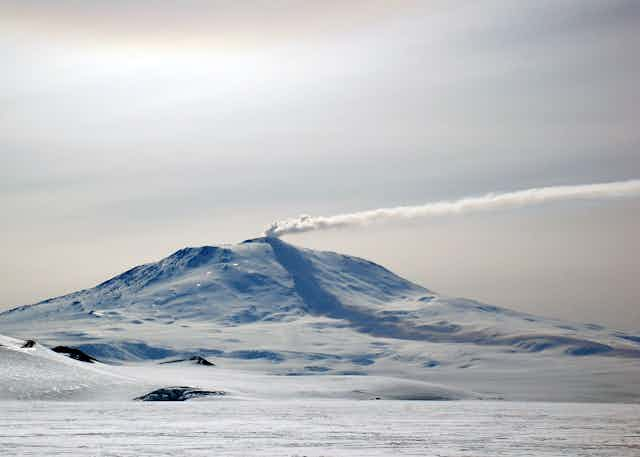Antarctica was once covered in lush, subtropical forests, inhabited by diverse plants and animals including large dinosaurs.
That’s going back many millions of years. These days, Antarctica is 99.7% covered in ice, and the 0.3% of land that is ice-free is home to diverse and unique ecosystems on considerably smaller scales, made up of mosses, lichens and various invertebrate animals such as mites and tiny nematode worms.
Many of these species show evidence of having been on the continent for millions of years, but if Antarctica is pretty icy now, it was certainly much icier during the last ice age, which peaked around 20,000 years ago (the Last Glacial Maximum).
Surviving the icy cold
How could species that need ice-free land to live have survived on the continent through the intense glacial cycles that characterised the last couple of million years?

Penguins, albatrosses, seals and other large, charismatic animals that most people usually associate with Antarctica have the luxury of being able to travel long distances by air or sea. These animals could easily travel north in cold periods to find ice-free land for breeding, and return to the south in warmer periods as the ice receded.
Most of Antarctica’s purely land-based biodiversity is much smaller and less mobile, so as the Earth entered an ice age and glaciers expanded, few species would be have been able to move to warmer, lower latitudes. Trapped on an increasing inhospitable continent, many would have gone locally or totally extinct – but some survived.
New evidence provides an intriguing solution to the mystery of how Antarctic species could have clung on through ice ages.
Warmth in the cold

There are many volcanoes in Antarctica and some have large magma chambers that can provide heat to the surface for hundreds of thousands of years. When we examined species richness patterns across the whole continent, we found there are more species close to these volcanoes, and fewer further away. The study details are released this week in Proceedings of the National Academy of Sciences of the United States of America (PNAS).
These patterns indicate that the volcanoes have sheltered diverse life over long periods, including during ice ages. It makes sense. Like a hot water bottle on a cold night, the volcanoes would have provided warmth, and helped to ward off the encroaching ice, as the planet entered a period of deep freeze.
As well as melting areas of ice on the surface, steam from volcanoes can cause the formation of extensive cave systems beneath the glaciers, tens of degrees warmer than outside.
These geothermally warmed environments could have supported biodiversity through the most intense glacial periods. Then, as the world warmed and more ice-free areas became available, chance events would have allowed some species to disperse away, stepping-stone style, to new habitats.
A new spread of life
A bird could land on a volcano, then fly to a nearby ice-free area, taking with it a few mites and moss spores on its feet. Strong winds could blow spores and eggs around.
Over time, the new patches would be colonised by subsets of the original community – but the further away from the source, the fewer the species that would be likely to establish, leading to the diversity gradient we see today, with decreasing species richness away from volcanoes.
These findings have important implications for the conservation of Antarctica’s unique life. Many Antarctic species are found nowhere else in the world. For instance, nearly 60% of Antarctic invertebrates (including mites, springtails and worms) are endemic.

As humans continue to have an impact on the continent’s environment, directly (such as through tourism) or indirectly (through human-accelerated climate change and pollution), and as people turn their eyes more frequently towards Antarctica for resources, we need to make urgent conservation priorities to safeguard Antarctic biodiversity.
Geothermal regions appear to be diversity “hotspots”, and making sure they are not too heavily impacted by human activities could therefore help to protect a wide range of Antarctic species.
Broader relevance
Although this research focused on Antarctica, the concept of geothermal ice-age safe-havens could also help to explain the persistence of life in glaciated regions elsewhere.
Genetic evidence from a range of species suggests that, even in the regions covered by polar ice caps in the Northern Hemisphere during the last ice age, some plants and animals survived. Could some of these have capitalised on geothermal heat from volcanoes (or from radiogenic decay of bedrock) to weather the long freeze?

Could geothermal areas also help to explain the persistence of simple life through periods when the Earth is thought to have been completely covered in ice – the Snowball Earth periods, hundreds of millions of years ago?
As with all scientific research, the findings have raised interesting new questions that future studies can tackle. For example, genetic work is already underway to see whether these diversity patterns are the same within species as they are between species.
Most people think of volcanoes as destructive and frightening, but this research shows that for many species in icy regions, volcanoes might represent something much more positive – a chance for survival in an extreme and harsh climate.

